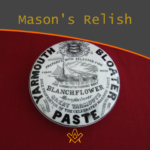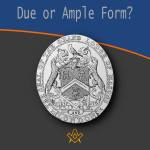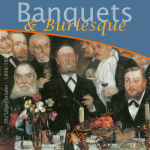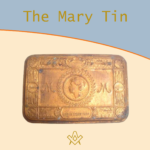Jacob’s Ladder occupies a conspicuous place among the symbols of Freemasonry being on the First Degree Tracing Board, the most conspicuous and first seen by the candidate on his initiation; a vision of beauty and intrigue for the newly admitted.

An artefact in Royal Kent Lodge No. 15 has an unusual representation of Jacob’s Ladder as a roundel with an over-structure, few of which now exist.
Reference to it dates back in the archives to Brother Buckeridge, the erstwhile Secretary (1895-1931) who saved scraps of Masonic information which finally ran to five volumes.
Better described as a tripod over a mantle with a smooth ashlar pendant on a winch rope; assumed to adorn the Senior Warden’s pedestal.

Rounds among the Hebrews were originally supposed to be infinite. The Essenes first reduced them to seven,called the Sephiroths, whose names were, Strength, Mercy, Beauty, Eternity, Glory, the Foundation and the Kingdom.
This relates to the tetragrammaton and its permeations and assent to enlightenment or union from Greek τετραγράμματον, meaning “(consisting) of four letters” is the Hebrew theonym יהוה, commonly transliterated into Latin letters as YHWH.
It is one of the names of the national God of the Israelites used in the Hebrew Bible. Yahweh is the pronunciation most widely accepted by Hebrew scholars.
The name may be derived from a verb that means “to be”, “exist”, “to cause to become”, or “come to pass”.
Its true origin was lost among the worshippers of the Pagan rites, but the symbol itself was retained. Among them it was always made to consist of seven rounds.
In the Persian Mysteries of Mithras, it was symbolical of the Soul’s approach to perfection.
These rounds were called gates: and in allusions to them, the Candidate was made to pass through seven dark and winding caverns.
Each of these caverns was the representative of a state of existence through which the Soul was supposed to pass in its progress from the first to the last.
In his Hebrew Dictionary, the Hebrew scholar Wilhelm Gesenius (1786–1842), supports the use of “Yahweh” (which would have been pronounced [jahwe], with the final letter being silent) because of the Samaritan pronunciation Ιαβε, as reported by Theodoret of Cyrus, and that the theophoric name prefixes YHW [jeho] and YH [jo] can be explained from the form “Yahweh”.
Today many scholars accept Gesenius’s proposal to read YHWH as יהוה,, as the best scholarly reconstructed vocalised Hebrew spelling of the tetragrammaton (the Hebrew name of God).
Most scholars believe “Jehovah” to be a late (c. 1100 CE) hybrid form derived by combining the Latin letters JHVH with the vowels of Adonai, but there is some evidence that it may already have been in use in Late Antiquity (5th century).
“Jehovah” was popularised in the English-speaking world by William Tyndale and other pioneer English Protestant translations such as the Geneva Bible and the King James Version and is still used in the New World Translation.
It is no longer used in most English translations, with LORD usually used instead, generally indicating that the corresponding Hebrew is YHWH or Yehowah.
In the Lodge Room these types of pieces and especially the zodiac used to be a very common feature, especially relating to the main theme in masonry.
A similar piece exists on the ceiling of the Grecian temple at the Andaz hotel, adjacent to Liverpool Street Station but now not in use for Masonic purposes.
It depicts the ladder in the centre of the zodiac proceeding towards a blazing star and draws the “eye” to the centre which has its own significance.
Likewise, the roundel shows the order of the zodiac, starting with Aries at mid-heaven and working anti clockwise is Aries, Taurus, Gemini, Cancer, Leo, Virgo, Libra, Scorpio, Sagittarius, Capricorn, Aquarius, Pisces along with other symbolic depictions.

From a believer’s perspective, Jacob’s Ladder has the twelve positive and negative aspects of each of the signs of the zodiac, which equals twenty-four.
Twenty-four in its triplicity is seventy-two, the number of the rounds of the ladder of Jacob. Each round of the ladder is a doubled equalling 144.
It is also a metaphysical blueprint for the laws present in nature but ultimately in the eye of the beholder.
The import of an otherwise common tenet, Jacob’s Ladder, can be traced with some of its significance and meaning showing representations for both Religion and Masonry.
Masonically, the Royal Arch tracing board, which is rarely seen or known, also has similar connotations and is worthy of study.
Royal Kent Lodge has a long and distinguished history reaching back at least thirty years before its Constituted date of 1752 and Warrant of 1758.
It is not surprising such artefacts are to be found in its darkest dusty recesses, which may forever intrigue questioning Brethren. However, sadly not in use today in the modern Craft era but open to those who search.
Article by: Paul Gardner

Paul was Initiated into the Vale of Beck Lodge No 6283 (UGLE) in the Province of West Kent, England serving virtually continuously in Office and occupying the WM Chair on three occasions.
Paul joined Stability Lodge No 217 in 1997 (UGLE) and now resides with Kent Lodge No 15, (UGLE) the oldest Atholl Lodge with continuous working since 1752, where he was Secretary and now Assistant Secretary and archivist, having been WM in 2002.
In Holy Royal Arch he is active in No 15 Chapter and Treasurer of No 1601, which was the first UGLE Universities Scheme Chapter in 2015.
He was Secretary of the Association of Atholl Lodges which maintains the heritage of the remaining 124 lodges holding ‘Antients’ Warrants and has written a book on Laurence Dermott. - https://antients.org
Recent Articles: by Paul Gardner
 Exchanged the Sceptre for the Trowel Explore the intriguing history of Royals and Freemasonry following the new Monarch's Coronation. From Prince Albert's initiation to the influence of George II and beyond, discover why royalty has long exchanged the sceptre for the trowel, shaping society and maintaining power through this ancient craft. |
 Unearth the mystic origins of Freemasonry in 'That He May Be Crafted.' Paul Gardner explores the symbolic use of working tools from the earliest days of this secret society, revealing a time when only two degrees existed. Delve into this fascinating study of historical rituals and their modern relevance. |
 Paul Gardner looks to a time when politics and Masonry were not precluded, but shush! This was London Masons and the Spitalfields Act of 1773-1865. |
 That rank is but the guinea’s stamp, the man himself’s the gold. But what does this mean, even given the lyric and tone of Burns’ time? It is oft times used in a derogatory sense, (somewhat in good humour) between Masons (or not) on the achieving of honours. But its antecedents are much more complex than that. |
 John and Timothy Coleman Blanchflower were initiated in Walpole Lodge, No. 1500, Norwich England on 2 December 1875; noted as a purveyor of ‘sauce’ to masons! |
 Jacob’s Ladder occupies a conspicuous place among the symbols of Freemasonry being on the First Degree Tracing Board, the most conspicuous and first seen by the candidate on his initiation – a vision of beauty and intrigue for the newly admitted. |
 During a detective hunt for the owner of a Masonic jewel, Paul Gardner discovered the extraordinary life of a true eccentric: Dr William Price, a Son of Wales, and a pioneer of cremation in Great Britain. Article by Paul Gardner |
 Paul Gardner tells the story of his transition from one rule book to another – from the Book of Constitutions to the Rule Book for Snooker! |
 Due or Ample Form? What is ‘Ample’ form, when in lodges the term ‘Due’ form is used? |
 The Butcher, the Baker, the Candlestick Maker Paul Gardner explores the Masonic link between provincial towns’ craftsmen, shop keepers and traders in times past. Many remain in the modern era and are still to be found on the high street. |
 Masonic dining and banquets, at least for the annual Investitures, were lavish, and Kent Lodge No. 15, the oldest Atholl lodge with continuous working from 1752, was no exception. |
 The ‘cable-tow’ or ‘noose’ is used in Craft Masonry as part of the ritual, as are ropes and ties in other degrees - but what does it symbolise? |
 Paul Gardner reflects on those days of yore and the “gentleman footballer” in Masonry |
 What is the Masonic connection with the 1914 Christmas Mary Tin |
 That Takes the Biscuit - The Patriot Garibaldi Giuseppe Garibaldi Italian general and politician Freemason and the Grand Master of the Grand Orient of Italy. |
 W.Bro. Paul Gardner looks at a mid 19th century artefact and ponders ‘Chairing’ |
masonic knowledge
to be a better citizen of the world
share the square with two brothers

click image to open email app on mobile device








